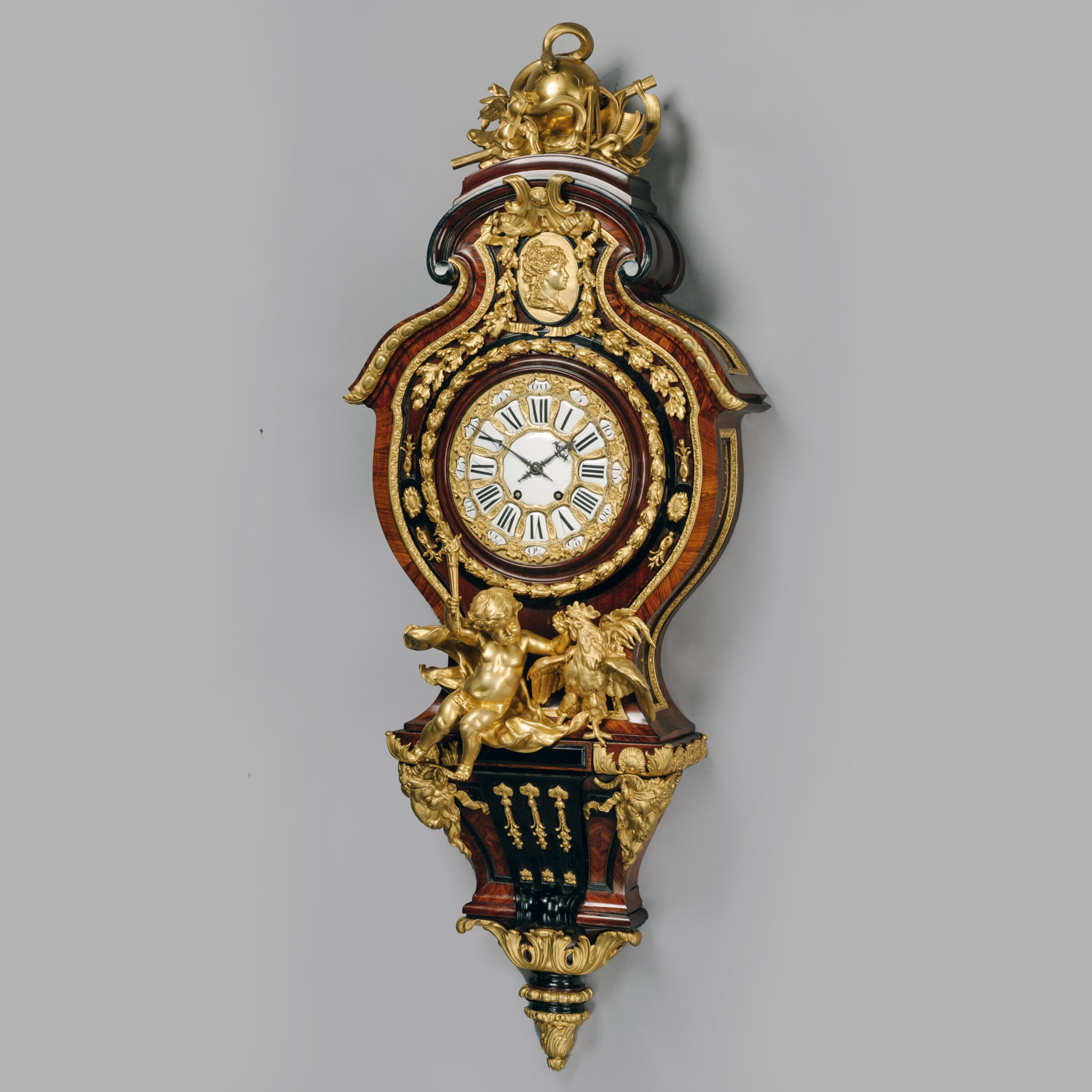After Giles-Marie Oppenord
An Important and Extremely Rare Grand Figural Cartel Clock
£65,000
An Important and Extremely Rare Grand Figural Cartel Clock, After a Design by Gilles-Marie Oppenord. Of grand proportions and of exceptional quality...
Dimensions
Height: 144 cm (57 in)Width: 55 cm (22 in)
Depth: 27 cm (11 in)
Description
An Important and Extremely Rare Grand Figural Cartel Clock, After a Design by Gilles-Marie Oppenord.
Of grand proportions and of exceptional quality this rare cartel clock is after an eighteenth-century drawing from circa 1710 by Gilles-Marie Oppenord (1685-1742) Directeur des Manufactures Royales, which was subsequently engraved by Gabriel Huquier and published in 1748.
The circular gilt-bronze foliate cast dial is inset with porcelain outer Arabic numerals and inner porcelain Roman numerals and a pair of steel fleur-de-lys hands for the hours and minutes. The clock has an eight-day twin-train square-plate movement with anchor escapement, striking on a bell. The movement stamped ‘9520’.
The inspiration for this remarkable clock is a drawing from circa 1710 for the Royal clock maker J. Thuret, by Gilles-Marie Oppenord; now in the collection of the Cooper Hewitt Museum, New york.
Oppenord’s elaborate visual language evident in this eclectic design, encompassed the formality of Louis XIV’s courtly architecture and the playfully subversive Rococo style which he helped to invent alongside Juste-Aurèle Meissonnier.
Renowned by his contemporaries for the quality of his draftsmanship; his drawings were collected by fellow designers and artists, including André-Charles Boulle (1642-1732) and Antoine Watteau (1684-1721).
The collector, engraver, and print publisher Gabriel Huquier (1695-1772) owned over 2,000 of his drawings and published three major series of prints, including ‘Le Grand Oppenord’ (1748-51).
His drawings and designs proved influential throughout the 18th and 19th centuries, with Huquier’s engravings reproduced in Paris in the 1880’s in ‘Recueil des oeuvres de Gille-Marie Oppenord … contenant deux mille motifs avec fragments de consoles, agrafes, cartels … à l’usage des architectes et décorateurs, joailliers et orfèvres, ébénistes …’
The exuberant clock case displays a profusion of decorative motifs, sumptuously modelled in gilt-bronze.
The overall iconography of the clock can be read as Love Conquering Time, the latter in the form of passing time; here depicted by the scythe and snake coiled around a globe to the cresting.
The superbly cast playful bronze putto figure, cast almost in the round, is symbolic of love and is here accompanied by a Rooster or Cockerel, thus illustrating the triumph of light over darkness.
The exceptional bronze ram’s heads to the sides of the cartel are superbly cast and chiselled and reminiscent of the works of André-Charles Boulle, who Oppenord closely associated.
French, Circa 1880
Date
Circa 1880
Origin
French
Medium
Gilt-Bronze & Mahogany
A prolific and imaginative draftsman, Oppenord produced creative designs for everything from wall-lights, candlesticks, clocks and chandeliers to large scale architectural projects, complete interiors and church monuments. Though his designs were initially influenced by the Baroque, he then began working in a lightness of touch, introducing sinuous asymmetrical lines whose creative designs played a significant role in the development of the early Rococo style.
He was the son of the ébéniste Alexandre-Jean Oppenord and grew up in the Palais du Louvre, where his father had been given an apartment by the king. A pupil of Jules Hardouin Mansart, he was granted an income and went to work in Rome for eight years, where he was influenced by Bernini and Borromini. But after his return to France he began to adopt an early Rococo style and began designing domestic interiors. His main patron was the Régent, duc d’Orléans who appointed him directeur des Manufactures Royales.
However, his main activity was that of an interior designer and as such he oversaw the design of the interior and all the furnishings for the duc’s residence at the Palais-Royal. Subsequently, under the direction of Robert de Cotte he was involved in the interior design for the decor at the Elector’s Palace in Cologne and in addition worked on the interior decoration at château de la Grange at Yerres.
Whilst a leading figure in his day, Oppenord’s influence became far greater after his death when many of his designs were engraved by Huquier and subsequently published as a series.
YOU MAY ALSO LIKE
-
£45,000 Add to cart

Etienne Maxant
A Regence Style Gilt-Bronze and Boulle Marquetry Inlaid Grand Cartel de Applique, In the Manner of André-Charles Boulle
-
£48,000 Add to cart

A Very Fine Ormolu Mounted Green Stained Horn Clock and Barometer Set
-
£3,200 Add to cart

A Patinated and Gilt-Bronze Hanging Clock, with an enamelled dial and Arabic Numerals























 Print
Print